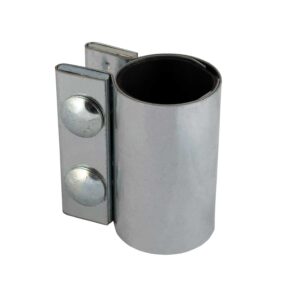In a dry bulk material handling system, compression couplings are used to connect pipes with an airtight seal. This allows you to convey your materials through your system smoothly and efficiently. In fact, some compression couplings with large flow diameters can even withstand pressure of more than 10,000 psi.
But your system is only as strong as its weakest link. Installing ill-fitting compression couplings can result in leaks, pressure drops, and excessive power consumption, all of which take additional time and money to fix.
Understanding how to choose the right compression couplings for your pneumatic conveying system can mean the difference between optimal productivity and operating at a loss. In this blog, we explore three key specifications that, when chosen correctly, can safeguard you against system failure: outer diameter, number of bolts, and gasket material.
Features of compression couplings
Outer diameter
The most important factor in selecting compression couplings for your pneumatic conveying system is to make sure they’re compatible with the pipes they’ll be connecting. Your fittings need a broad enough outer diameter (OD) to enclose the ends of each pipe. But they also need to be tight enough to create an airtight seal.
You might think that ordering the tightest compression couplings possible would seal your pipes most effectively. However, couplings that are overtight can warp the pipes they’re attached to. This prevents an airtight seal from forming and actually creates leaks where they might not otherwise have existed. When this happens, you not only need to replace your compression coupling but also the damaged pipes.
If you’re not sure what size OD would best suit your system, we’re here to help. We provide compression couplings with OD sizes of 1”-12.75”, and our friendly team can offer expert advice on which option is right for you.
Number of bolts
The greater the force with which your materials move through your system, and the denser those particles are, the more your pipes vibrate. If these vibrations knock your components out of alignment, it puts excessive strain on your bearings and limits the productive capacity of your system.
The bolts on a compression coupling hold the two halves of the component together tightly. This protects your system against the impact force of the materials you convey, keeping your components in place. The more bolts a compression coupling has, the greater its sealing and stabilizing properties.
Compression couplings with a larger OD of course need more bolts to hold them together. But the more bolts on a coupling, the more expensive it’ll be, if only slightly. So to manage your budget effectively, you should purchase compression couplings with just the right number of bolts to keep your pipes stable.
If you’re purchasing a 2” OD compression coupling for a system that conveys light materials like plastic pellets, you might only need two bolts. Five bolts would be better if you’re purchasing a 6.62” OD coupling to convey dense mining product. For advice on how many bolts you need, feel free to get in touch.
Gasket material
The gasket is the part of a compression coupling that creates the airtight seal. It’s an elastic component that covers the intersection between two adjoining pipes, filling in the irregularities in their surfaces. For a gasket to function effectively, it must be compressed enough to form a complete barrier against the external environment.
While most gaskets are made of rubber, different types of rubber are better suited to different applications. To help you choose the right gasket for your pneumatic conveying system, let’s explore the characteristics of three popular gasket materials.
Natural rubber gaskets
Natural rubber is derived from the latex harvested from the Hevea tree and contains the polymer chain polyisoprene. It’s a widely available, cost-effective, and hardwearing gasket material option most commonly used in chemical processing facilities.
The main features of natural rubber gaskets are:
- Easy to manufacture: In its liquid state, natural rubber flows easily into a gasket mold. This makes it quick and easy to produce. Therefore, it’s also highly affordable.
- Easy to compress: Natural rubber compresses and stretches without degradation, so it can form an effective seal around pipe surfaces.
- High chemical resistance: Since natural rubber is highly compatible with both acids and alkalis, it’s an excellent choice for most chemical applications.
- High-temperature resistance: This gasket material can withstand temperatures of up to 1832oF, making it suitable for high-temperature applications.
- High wear resistance: The high tensile strength and durability of natural rubber give it a long product lifespan. Because it doesn’t need to be replaced often, it’s likely you’ll need to spend less money on replacements.
Natural rubber is a good all-around gasket material option that won’t put a large strain on your budget. But while it’s fairly resistant, it’s typically outclassed by synthetic options. Similarly, these gaskets can only handle pressure of around 150 psi, meaning they’re suitable mainly for low- to medium-pressure applications.
Silicone gaskets
While natural rubber is carbon-based, silicone rubber is instead composed of a silicon-oxygen chain. As silicone is FDA-approved, silicone gaskets are widely used in food and pharmaceutical processing plants. They’re also highly durable and versatile, making them an effective choice for industrial applications.
The main features of silicone gaskets include:
- Compression set reliance: A compression set of 100% means that a material will never return to its original thickness when compressed. When a gasket deforms like this, the seal will fail, leading to leaks and contamination. But silicone rubber has an extremely low compression set. That means it won’t deform even when subjected to high pressure for a long time, giving you an effective seal that lasts.
- Food safe: Silicone is FDA-approved as non-toxic and doesn’t affect the taste or flavor of the products it touches. This makes it suitable for food processing and medical plants.
- High-temperature resistance: This versatile material can withstand temperatures of -94oF – 428oF. It doesn’t freeze or crack at low temperatures, nor does it melt at high temperatures.
- Flame retardant: The low flammability levels of silicone gaskets make them an excellent option for industries that produce extreme heat. They meet the Underwriters Laboratories (UL) testing requirements for fire safety and flame resistance, allowing them to satisfy UL94V0, UL94V1, and UL94HF1 flammability standards.
- Water repellent: Silicone repels water and resists moisture. This makes it popular for pneumatic conveying systems that convey wet or moist products, or those that produce high condensation.
The downside to silicone gaskets is that they’re more expensive than their natural rubber counterparts. However, they offer much higher performance in many applications and remain reliable and stable. Since they don’t require frequent maintenance and take a long time to wear, you might find yourself spending less on silicone gaskets in the long run.
Neoprene gaskets
Neoprene is a versatile synthetic rubber produced from the emulsion polymerization of chloroprene. The chlorine in the polymer chain helps improve a neoprene gasket’s resistance to oxidation, oil, and ozone.
The main features of neoprene gaskets include:
- High tensile strength: Neoprene has a tensile strength in the range of 900–1,000 psi.
- Tear resistant: External damage can be a serious problem for compression coupling gaskets. But neoprene resists cuts and tears well, protecting your pipes both internally and externally.
- Highly elastic: Neoprene rubber returns to its original shape once pressure is removed. This makes it particularly effective at enduring and absorbing the shock of repetitive force.
- Good temperature resistance: This material can withstand temperatures of -400F – 248oF.
- Good all-purpose resistance: Neoprene resists damage and degradation from many sources. It offers good protection against abrasion, combustion, oxidation, and water, great protection against chemicals and corrosion, and exceptional protection against oil and ozone.
Compared to natural rubber and silicone, neoprene gaskets can be used much more flexibly across a wide range of industries. This material also sits between the other two in price.
Protect your pipes with high-performing custom compression couplings
When you visit the PneuComponents online store, you can order zinc-plated compression couplings with custom ODs, numbers of bolts, and gasket materials without lengthy order forms or long wait times. Simply select your custom coupling and complete the order, and your new components will be with you in a flash. That means you can save a ton of time and hassle while keeping your system airtight with durable industry-leading components.
Still not sure which compression couplings are right for your system? No problem. Get in touch with our knowledgeable support team today for free comprehensive advice.
As a part of Progressive Products, Inc, PneuComponents draws on over 40 years of technical expertise and industry innovation to give you the best possible guidance and service. Progressive Products is an industry-leading manufacturer of abrasion-resistant components, and their products are used in pneumatic conveying systems worldwide.
-
Couplings$12.03 – $48.28

